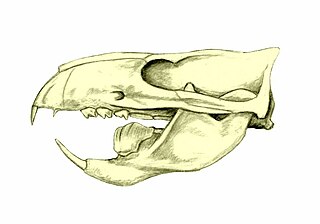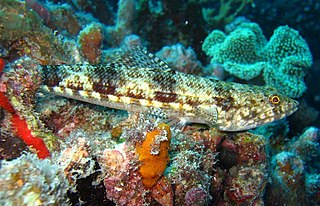
Tetraodontiformes, also known as the Plectognathi, is an order of ray-finned fishes which includes the pufferfishes and related taxa. This order has been classified as a suborder of the order Perciformes, although recent studies have found that it, as the Tetraodontoidei, is a sister taxon to the anglerfish order Lophiiformes, called Lophiodei, and have placed both taxa within the Acanthuriformes. The Tetraodontiformes are represented by 10 extant families and at around 430 species overall. The majority of the species within this order are marine but a few may be found in freshwater. They are found throughout the world.
Albionbaataridae is a family of small, extinct mammals within the order Multituberculata. Fossil remains are known from the Upper Jurassic and Lower Cretaceous of Europe and Asia. These herbivores lived their obscure lives during the Mesozoic, also known as the "age of the dinosaurs." They were among the more derived representatives of the informal suborder "Plagiaulacida". The taxon Albionbaataridae was named by Kielan-Jaworowska Z. and Ensom P.C. in 1994.

Ptilodontoidea is a group of extinct mammals from the Northern Hemisphere. They were generally small, somewhat rodent-like creatures of the extinct order Multituberculata.
Cimolodontidae is a family of fossil mammals within the extinct order Multituberculata. Representatives are known from the Upper Cretaceous and Paleocene of North America. The family Cimolodontidae was named by Othniel Charles Marsh in 1889 and is part of the suborder Cimolodonta within the superfamily Ptilodontoidea.
Microcosmodontidae is a poorly preserved family of fossil mammals within the extinct order Multituberculata. Representatives are known from the Lower Paleocene of North America. The family is part of the suborder Cimolodonta. Other than that, their systematic relationships are hard to define.

Tylopoda is a suborder of terrestrial herbivorous even-toed ungulates belonging to the order Artiodactyla. They are found in the wild in their native ranges of South America and Asia, while Australian feral camels are introduced. The group has a long fossil history in North America and Eurasia. Tylopoda appeared during the Eocene around 50 million years ago.

Spirula spirula is a species of deep-water squid-like cephalopod mollusk. It is the only extant member of the genus Spirula, the family Spirulidae, and the order Spirulida. Because of the shape of its internal shell, it is commonly known as the ram's horn squid or the little post horn squid. Because the live animal has a light-emitting organ, it is also sometimes known as the tail-light squid.

Aulopiformes is a diverse order of marine ray-finned fish consisting of some 15 extant and several prehistoric families with about 45 genera and over 230 species. The common names grinners, lizardfishes and allies, or aulopiforms are sometimes used for this group. The scientific name means "Aulopus-shaped", from Aulopus + the standard fish order suffix "-formes". It ultimately derives from Ancient Greek aulós + Latin forma, the former in reference to the elongated shape of many aulopiforms.

Vampyromorphida is an order of cephalopods comprising one known extant species and many extinct taxa. Physically, they somewhat resemble octopuses, but are often called vampire squids. Unlike octopuses, their eight arms are united by a web of skin, and two smaller cilia are also present. Properly speaking, the vampire squid does not possess cilia, but cirri. Unlike most cephalopods, which are high-energy hunters, the vampire squid has an extremely low metabolic rate. This adaptation means it requires less oxygen and its food lasts longer, helping it conserve energy and thrive in these harsh deep-sea conditions. Studies show its oxygen consumption is among the lowest of any cephalopod, allowing it to occupy a competition-free niche in the deep sea where few predators or competitors can follow, since not many can survive.

Eosuchians are an extinct order of diapsid reptiles. Depending on which taxa are included the order may have ranged from the late Carboniferous to the Eocene but the consensus is that eosuchians are confined to the Permian and Triassic.

The Afroinsectiphilia is a clade that has been proposed based on the results of recent molecular phylogenetic studies. Many of the taxa within it were once regarded as part of the order Insectivora, but Insectivora is now considered to be polyphyletic and obsolete. This proposed classification is based on molecular studies only, and there is no morphological evidence for it.

Feliformia is a suborder within the order Carnivora consisting of "cat-like" carnivorans, including cats, hyenas, mongooses, viverrids, and related taxa. Feliformia stands in contrast to the other suborder of Carnivora, Caniformia.

Notioprogonia is a suborder of the extinct mammalian order Notoungulata and includes two families, Henricosborniidae and Notostylopidae.
Shimanskya is a late Carboniferous fossil tentatively interpreted as an early spirulid.

Errantia is a diverse group of marine polychaete worms in the phylum Annelida. Traditionally a subclass of the paraphyletic class Polychaeta, it is currently regarded as a monophyletic group within the larger Pleistoannelida, composed of Errantia and Sedentaria. These worms are found worldwide in marine environments and brackish water.

Carcinosomatoidea is an extinct superfamily of eurypterids, an extinct group of chelicerate arthropods commonly known as "sea scorpions". It is one of the superfamilies classified as part of the suborder Eurypterina.

Eurypterina is one of two suborders of eurypterids, an extinct group of chelicerate arthropods commonly known as "sea scorpions". Eurypterine eurypterids are sometimes informally known as "swimming eurypterids". They are known from fossil deposits worldwide, though primarily in North America and Europe.

Pholidotamorpha is a clade of placental mammals from mirorder Ferae that includes the order Pholidota and extinct order Palaeanodonta.

Eupholidota is a suborder of pangolins that includes two superfamilies: extant Manoidea and extinct Eomanoidea.

Manoidea ("spirits") is a superfamily of pangolins from suborder Eupholidota that includes extant family Manidae, extinct family Patriomanidae and extinct genus Necromanis.
















